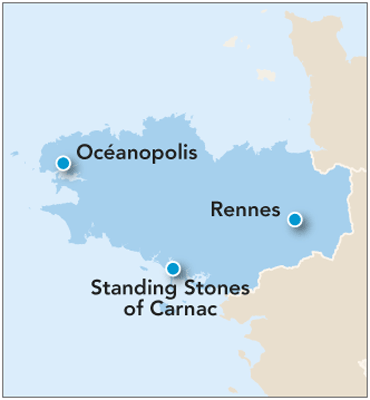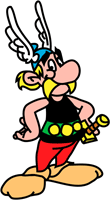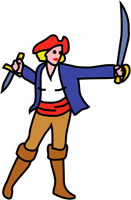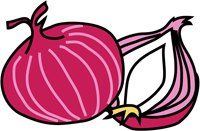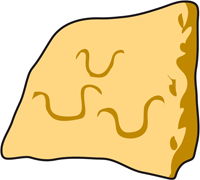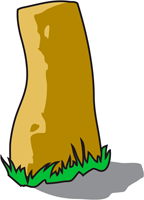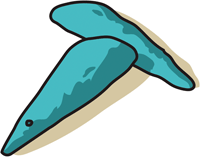< Brittany
1. Rennes
2. Forêt de Brocéliande
3. Dinan
4. St-Malo
5. Océanopolis, Brest
6. Roscoff and the Pays du Léon
7. Paimpol
8. Douarnenez
9. Standing Stones of Carnac
10. Vannes
11. Lorient
12. Pont-Aven
13. Quimper
< Brittany
1. Rennes
Britanny’s young and vibrant capital
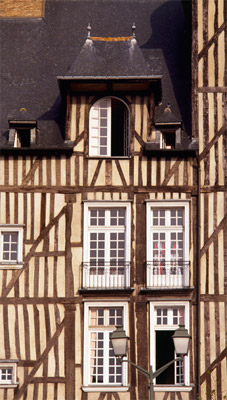
Half-timbered house, Rennes
Although named after the local Celtic tribe, Rennes only started making a name for itself in 1356–7, when the great Breton knight Bertrand du Guesclin defended it from the English in the Hundred Years’ War. Made the capital of Brittany in 1551, when the region became part of France, Rennes is one of the country’s fastest-growing cities, with 60,000 university students, the Champs Libres cultural centre, a modern Métro and a lively calendar of music events.
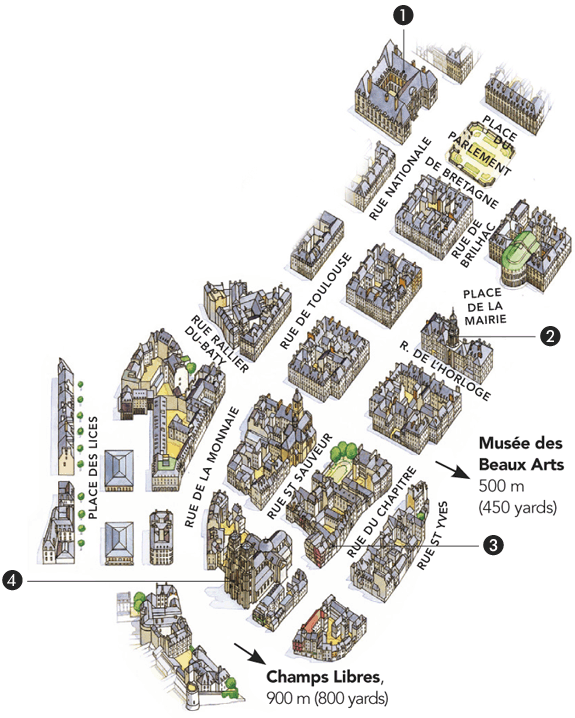
Key Sights
1. Parlement de Bretagne The 17th-century regional parliament is a fine example of French Classical style, its Grand Chamber oozing splendour.
2. Hôtel de Ville Built in 1720 by Jacques Gabriel, the town hall has a distinct bulb-topped belfry, an elaborate grand stair and a wedding hall.
3. Timber-framed houses The house at No. 22 Rue du Chapitre has some sculpted carvings from 1580.
4. Cathédrale St-Pierre Gradually rebuilt after its Gothic façade collapsed in 1490, this cathedral has a beautiful 16th-century altarpiece of the Nativity.
• Musée des Beaux Arts Objects from ancient Egypt share space with paintings by Veronese, the Pont-Aven School and Picasso.
• Champs Libres This complex houses the Musée de Bretagne, which covers Brittany’s ancient and modern history, and L’Espace des Sciences, Rennes’ hightech science museum that has Merlin’s laboratory, a 3D Planetarium and other exhibits.
• Place des Lices Knights once jousted in the city’s most picturesque square, lined with 17th-century houses. On Saturdays it hosts one of the largest markets in France.

Left
Champs Libres Middle Musée des Beaux Arts Right Place des Lices
Kids’ Corner
Speaking Brezhoneg
One section in the Musée de Bretagne is devoted to Brezhoneg (Breton), a Celtic language related to Welsh and Cornish. The Asterix books have been translated into Breton. Try to speak a few words in the language:
Good Day! Demat! (de mat)
How are you? Penaos ‘mañ kont? (pen-os man ko?)
I’m fine, thank you. Mat eo ar jeu, trugarez. (mat ay o ju, tre gay)
Goodbye! Kenavo! (ken av o!)
Pancakes/Crêpes Krampouezh (cram-poo-aze)
Genius chemist
Rennes was the birthplace of Pierre Jean Robiquet (1780-1840), one of France’s greatest chemists. In 1805, while working with asparagus juice, he helped to discover a substance he called asparagin, the very first amino acid (one of the building blocks of life).
Asterix introduces the Roman world
Armorica, the “Place by the Sea”, the name of Brittany in ancient times, will be familiar to any fan of Asterix. The famous comic books offer a well-researched introduction into the Roman world at the time of Julius Caesar. A website by two Asterix fans provides a background to the geographical place names, words and items used in the books.
< Brittany
2. Forêt de Brocéliande
The Lady of the Lake’s realm
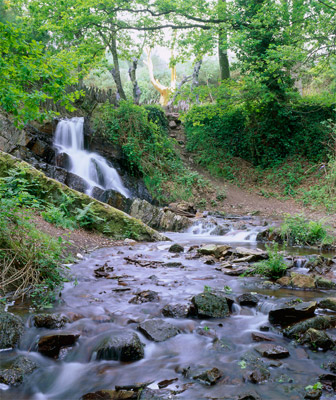
A stream rushing through the Forêt de Brocéliande
The Brocéliande, the last remnant of Brittany’s primeval forest, is steeped in Arthurian legends. Start at Paimpont, where the visitor centre provides free maps of places asso-ciated with Arthur, Merlin and the Knights of the Round Table, as well as guides to walks. To the north, near Concoret, is the lakeside Château de Comper, where the Lady of the Lake is said to have given Arthur his sword, Excalibur. Today, the castle hosts the Centre de l’Imaginaire Arthurien, presenting exhibitions on the Arthurian legends.
At the village of Tréhorenteuc, 11 km (7 miles) southwest of Concoret, the Chapelle du Graal (“Chapel of the Grail”) is renowned for its mix of Christian and pagan symbolism; it is near the beginning of a 4-km (3-mile) trail into the Val-sans-Retour (Valley of No Return – pick up a map at the Tréhorenteuc tourist office) where Morgan le Fay’s spell trapped faithless knights. A map points to sights in Brocéliande – a 1,000-year-old oak tree called the Chêne à Guillotin and a beautiful spring, the Fontaine de Barenton in the hamlet of La Folle-Pensée where Merlin the magician left a spell to cure madness.
Kids’ Corner
Lioness of Brittany
When her husband was executed for treason by the French, Jeanne de Clisson (1300–59) took revenge by becoming a pirate and beheading any French aristocrats she captured in the English Channel.
King Arthur in Brittany
In 1135, when Geoffrey of Monmouth wrote his History of the Kings of Britain, he claimed that many of his stories about Arthur came from Brittany. It is believed that the Britons who had escaped from the invading Angles and Saxons to Brittany may have cherished the legend of a mighty king who would have been able to defeat the invaders. Medieval writers were soon adding to Geoffrey’s tales, especially Chrétian de Troyes, who was the first to mention the Holy Grail.
< Brittany
3. Dinan
Walls and a hero’s heart
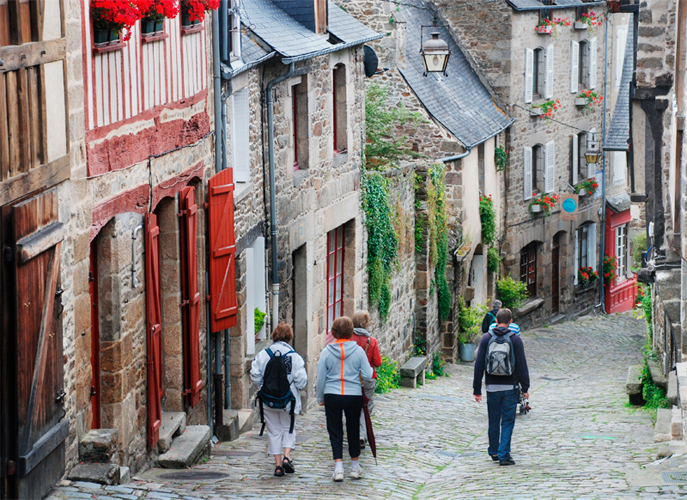
One of old Dinan’s winding cobbled streets
Walled Dinan is one of Brittany’s prettiest towns, where cobbled streets lined with timbered houses are still defended by an impressive château of 1380, now the Musée du Château, the local history museum. It was the hometown of Bertrand du Guesclin, the “Eagle of Brittany” who in 1357 defeated Englishman Thomas de Cantorbery in combat; his statue in the Place du Guesclin marks the spot. Although Bertrand du Guesclin was buried with the kings of France in St-Denis in Paris, his heart is in the 12th-century Romanesque church of St-Sauveur, which has some curiously carved capitals. Dinan’s landmark is its 15th-century Tour de l’Horloge (clocktower). The Musée du Rail has a splendid collection of model trains, which will enthral train lovers of all ages.
< Brittany
4. St-Malo
The city of corsairs
Sheltered on its islet, picturesque St-Malo has a history filled with adventure, corsairs and explorers. At the entrance to the old city, the Musée d’Histoire de St-Malo, housed in the Château des Ducs de Bretagne, displays paintings, astrolabes, ships’ models, scrimshaw, maps and other maritime artefacts. The Musée du Long Cours Cap-Hornier, inside the 30-m (100-ft) Tour Solidor, in the southern quarter of St-Servan, commemorates the history of sailing ships that rounded the dangerous Cape Horn in South America. The Demeure de Corsaire, one of the few mansions that escaped damage by Allied bombs in the World War II, was built by François-Auguste Magon, an 18th-century privateer and director of the French East India Company. The 12th-century Cathédrale St-Vincent had to be rebuilt after the war. A mosaic on the floor of the nave marks the spot where Jacques Cartier knelt to be blessed before setting off to claim Canada for France in 1534.
After his third and final voyage, Cartier retired to the Manoir de Limoëlou, located outside St-Malo on the Cancale Road. Today, it is known as the Musée Jacques Cartier. Older kids may enjoy it.
Kids’ Corner
In St-Malo, find out…
-
Which animal was the symbol of the Dukes of Brittany? (Hint: You can find it on the gate of St-Vincent)
-
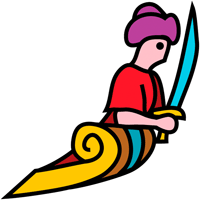
In Place des Champs-Vauvert is a statue of the “King of the Corsairs”. What is his name?
-
What were the tunnels under the Demeure du Corsaire originally used for?
< Brittany
5. Océanopolis, Brest
Shuffling penguins and dancing jellyfish
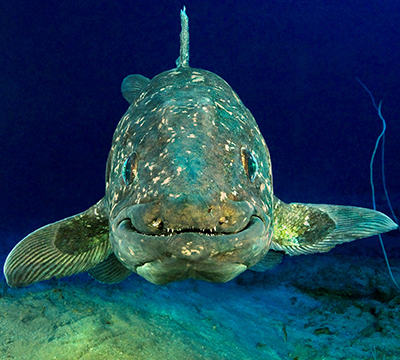
A Coelacanthe in the Pavillon Biodiversité
The city of Brest has always been closely linked to the ocean. A military port since the 17th century, it was flattened in a World War II siege but has now developed into an important centre for sea and polar research. This is reflected in its top attraction, Océanopolis, a magnificent ocean discovery park housed in a futuristic complex. An amazing 10,000 marine animals belonging to 1,000 species live in aquariums arranged in different pavilions, each with its own climate.
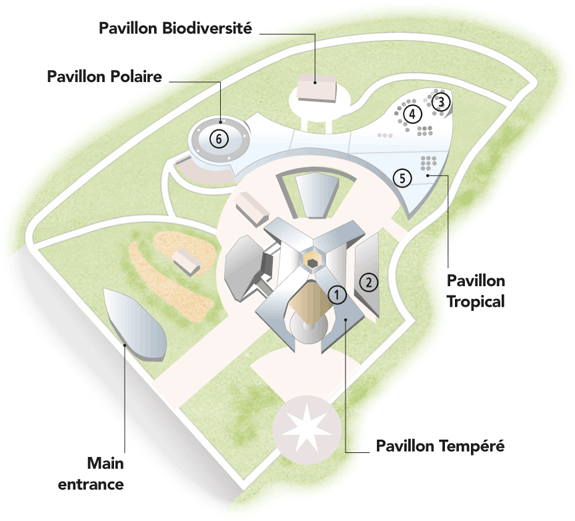
Key Features
1. Aquarium des Méduses This huge cylindrical aquarium contains aurelia aurita jellyfish that seem to dance a ballet in the current. Nearby tanks contain baby jellyfish polyps.
2. Flaque de Démonstration In an area that resembles a marine lab, visitors are invited to touch the scallops, starfish and sea urchins, or examine undersea flora and fauna through microscopes.
3. Serre Tropical Exotic hot weather trees, ferns and orchids collected in Guadaloupe make up this luxuriant Caribbean forest, with an aquarium full of fish from the Amazon.
4. Mur de Coraux Vivants This tremendous 13-m (42-ft) tank evokes the world of Australia’s Great Barrier Reef and the Indonesian archipelago, with 60 different colourful hard and soft corals.
5. Bassin des Requins This aquarium re-creates a Polynesian atoll, populated by four kinds of shark and many other fish. A glass-walled diving platform allows visitors to descend into their midst.
6. La Manchotière King, Gentoo and Rockhopper penguins make up what is Europe’s biggest penguin colony, frolicking in a sub-Arctic wonderland of water, snow and cliffs.

Left
Flaque de Démonstration Right Basin des Requins
Kids’ Corner
Find out more…
-
What do all types of penguins have in common?
-
What is the biggest fish on the planet and what does it eat?
-
In the Pavillon Tropical, find out which provides more oxygen – the Amazon rainforest or the ocean?
Inside the hooked bills
Penguins’ tongues have backward bristles to keep fish from sliding out of their mouths.
Isabelline penguins
One out of every 50,000 penguins is born brown and white instead of black and white. They are called Isabelline penguins, after Isabella of Austria, an archduchess who is believed to have not changed her underwear for three years!
A new set of teeth
Sharks have the most powerful jaws on earth. Each species of shark has a different kind of tooth, and they are constantly being replaced from a huge reserve of waiting teeth under the shark’s gums – a shark can go through 20,000 teeth in its lifetime!
< Brittany
6. Roscoff and the Pays du Léon
Pink onions and artichokes

Artichokes and other fresh produce in the local market, Roscoff
Roscoff is the port of the Pays du Léon, a region blessed with such a warm micro-climate that it grows most of France’s special pink onions, artichokes and cauliflowers. The Maison des Johnnies et de l’Oignon Rosé commemorates and explains the history of the pink Roscoff onion. Located high on a granite belvedere by the sea, the Jardin Exotique de Roscoff is filled with 3,500 colourful plants, mainly from the southern hemisphere. The town’s charming historic centre is dominated by the granite Église Notre-Dame-de-Croaz-Batz, decorated with ships, cannons, dragons and mermaids in high relief. Its Renaissance belltower is unusual; some say it resembles a giant cactus.
Kids’ Corner
Brittany’s “Johnnies”
In Roscoff in the 1820s, a local had the idea of weaving his pink onions into plaits and taking them to England to sell. By the 1930s there were over 1,000 bicycle-riding onion sellers in England. They became known as “Onion Johnnies” because so many Bretons are named Jean, French for John.
< Brittany
7. Paimpol
A steam train by the sea
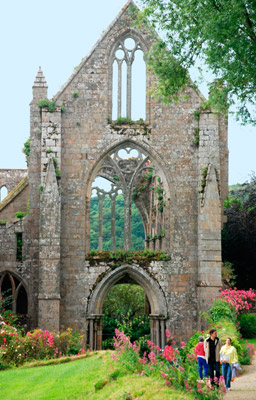
Visitors strolling in the gardens of L’Abbaye Maritime de Beauport
Paimpol is a pretty port where medieval pilgrims from Ireland, Cornwall and Scotland landed to begin the 1,520-km (946-mile) walk to the shrine of Santiago de Compostela in northwest Spain. In those days, they were received at L’Abbaye Maritime de Beauport, founded in 1202; although partly ruined, the abbey is set in a large park on a wild stretch of the coast. In town, the Musée de la Mer recalls how local cod fishermen spent six months of the year in Iceland. Also pay a visit to the Musée du Costume Breton, which displays the local costumes and elaborate coifs.
From May to early September, take a ride on La Vapeur du Trieux, a steam train from Paimpol to Pontriuex. On Saturdays in July and August, there is a magician on board.
< Brittany
8. Douarnenez
The kingdom of sardines
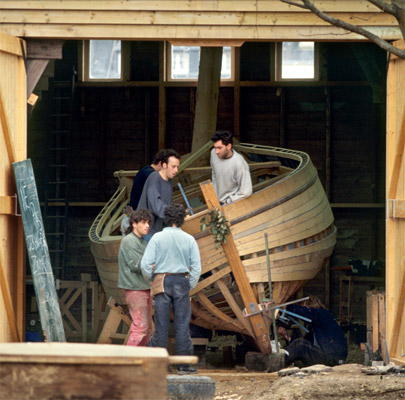
Men building a boat using traditional methods, Port-Musée, Douarnenez
South of Brest, the bustling sardine port of Douarnenez is home to the excellent Port-Musée. Installed in a former sardine cannery, the museum is dedicated to sailing traditions throughout the world, with a collection of boats to explore the water at Port-Rhu. Find out more about sardines along the Chemin de la Sardine, a walk dotted with French and English plaques on the fishery’s history, and at Penn Sardin, a specialist sardine shop full of fishy memorabilia. Douarnenez is also famous for kouign amann, a buttery flaky cake. Watch them being made at the Biscuiterie de Douarnenez.
Kids’ Corner
In the Port-Musée, find out…
-
How were the very first boats made?
-
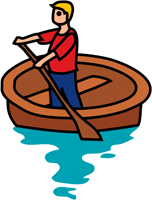
What kind of boats were used to fish for sardines?
-
What kind of fish were caught from the Taiwanese boat, the Tatara?
The city that drowned
King Gradlon of Cournouaille built a beautiful city for his daughter Dahut in the bay of Douarnenez. Called Ys, the city had a gate, which could only be opened for ships at low tide. But Dahut fell in love with a handsome man who was a devil in disguise. He asked her to steal the key of the gates from Gradlon. She did at high tide, and the waves engulfed Ys. They say bells of Ys can still be heard on a quiet night.
Fishy facts
If you are lucky you may see the big tails of a basking shark swimming off Brittany’s coast. Measuring up to 12 m (40 ft), they are the world’s second largest fish. Fortunately, in spite of their big mouths they are harmless filter feeders.
< Brittany
9. Standing Stones of Carnac
Obelix’s playground
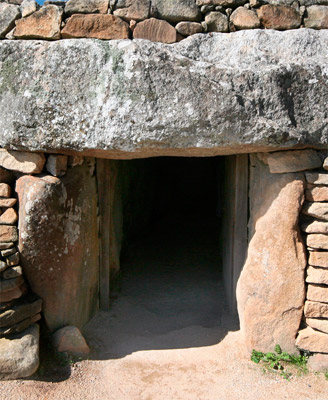
Table des Marchand
Situated on the Gulf of Morbihan, Carnac is France’s Stonehenge, with the longest alignments of standing stones (menhirs) anywhere. There are some 3,000 in all, arranged in such straight lines people thought they were Roman legions turned into stone by Merlin the magician. Erected before Merlin or Obelix, between 5,000 and 3,000 BC, these World Heritage alignments make up only part of a vast concentration of megalithic sites, near some of Brittany’s prettiest beaches.
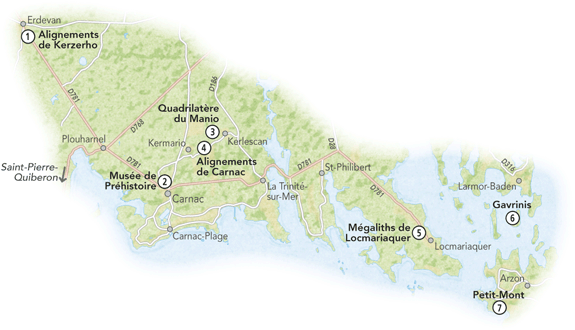
Key Sights
1. Alignements de Kerzerho These alignments consist of 1,100 stones, running in ten rows, with the Géant de Kezerho closing the west end.
2. Musée de Préhistoire One of the largest collections of prehistoric finds, this museum’s pottery and engravings trace the evolution of Neolithic construction and art.
3. Quadrilatère du Manio This rectangle of stones once surrounded a tumulus (burial mound). Nearby stands the 6-m (20-ft) Géant de Manio, Carnac’s tallest menhir.
4. Alignements de Carnac The menhirs, ranging in height from 0.6 m (2 ft) to 4 m (13 ft), are divided into Alignments de Ménac, Kermario and Kerlescan.
5. Mégalithes de Locmariaquer The Menhir d’Er Grah, at 21 m (68 ft), is the largest Neolithic monolith in Morbihan. Nearby is a tumulus and the Table des Marchand (Merchants’ Table) dolmen and cairn.
6. Gavrinis This is an islet with a cairn in which 23 of the 29 slabs lining its 14-m (46-ft) passage into a small burial chamber are decorated with swirling engravings resembling giant fingerprints.
7. Petit-Mont This 36 m (118 ft) cairn was built over a long period in concentric levels.

Left
Mégalithes de Locmariaquer Right Alignements de Carnac
Kids’ Corner
Look out for…
There are several recurring pictures on the stones such as the ones listed below. What do you think they represented?
The shield
The axe
The crook
Horns
Zigzags
Menhirs and dolmens
Menhirs and dolmens are found all over the world, but nowhere are they as dense as on the Morbihan coast. The names of the stones are derived from the Breton language. For instance, men is stone, hir is long; dole is table – hence menhir and dolmen.
Finding lost axes
In the Musée de Préhistoire do not miss the green Petit Rohu axe heads, found by holidaymakers in 2007. The axes come from the Italian Alps, proof that the Neolithic people had travelled far. Near the Petit Rohu beach are stone alignments under water. In 5,000 years, the sea has risen 500 m (1,640 ft). What is now the Gulf of Morbihan was once covered with farms and villages.
< Brittany
10. Vannes
Seahorses and butterflies
The lovely city of Vannes was hit by just one bomb in World War II, and it did not explode. The Morbihan department’s finest artefacts are on display in the handsome interior of the splendid 15th-century Château Gaillard’s Musée de Préhistoire et d’Archéologie. The medieval market houses the Musée des Beaux Arts, with Delacroix’s Christ on the Cross and Breton paintings. Nearby looms the massive Cathédrale St-Pierre, first built in the 13th century and remodelled many times since.
A free summer shuttle bus goes to the Parc du Golfe, home to the Aquarium du Golfe, specializing in tropical fish, cuttlefish and seahorses; and the Jardin des Papillons, which is a greenhouse that houses exotic flora and butterflies.
< Brittany
11. Lorient
Trawlers and sailing ships
France’s second most important fishing port was founded by King Louis XIV to serve as the port of his Compagnie des Indes Orientales, which also gave the town its name. Badly bombed in World War II, Lorient has since developed an array of maritime attractions, which starts off with a child-friendly tour. The colossal Base de Sous-Marins Keroman houses La Cité de la Voile Eric Tabarly, where families can learn about sailing, followed by an excursion in Lorient’s bay (Apr–Sep if weather permits) and also the submarine La Flore, with its interactive museum.
Kids’ Corner
Submarines in war
During World War II, the German troops that were safe in the submarine pens in Lorient refused to surrender. So the Allies bombed the city to choke off their supply routes. The Germans finally gave up in May 1945.
< Brittany
12. Pont-Aven
Crazy for art
Before 1886, the charming village of Pont-Aven was best known for its watermills, but that was before it found itself in the vanguard of French art, thanks to Paul Gauguin and a handful of like-minded artists who retreated here to work out a new theory they called Synthetism. Instead of just depicting a subject realistically, the artists painted their own emotional impression of it, in bold colours and with strong outlines. To learn more, visit the Musée des Beaux Arts, which houses works by members of the Pont-Aven school. As for the village, it remains a beacon for artists: the Chapelle de Trémalo, mecca for Gauguin followers holds an exhibition of Gauguin reproductions every year during Jul and Aug.
Kids’ Corner
In the Musée des Beaux Arts in Pont-Aven, find out…
-
Why did so many artists come to Pont-Aven in the 19th century?
-
Most artists work alone in studios. How did they work in Pont-Aven?
-
What were their favourite subjects?
-
How did they make the forms stand out boldly?
< Brittany
13. Quimper
Hand-painted pottery
Finistère’s proud capital Quimper, or “Quimperon en Cornouaille” as it likes to be known, is where the legendary King Gradlon of Cornouaille relocated after his beautiful city of Ys, built for his unruly daughter Dahut, was drowned by waves (see
The city that drowned). Gradlon’s hermit friend Corentin became the city’s first bishop and gave his name to the Gothic cathedral (the statue between its spires is Gradlon). Around it nestles a handsome art city, where the
Musée des Beaux Arts has paintings by the Pont-Aven school and Breton Realist painters. The
Musée Départemental Breton has artefacts showcasing 4,000 years of history as well as hand-painted faience, a traditional craft which is Quimper’s speciality. Watch faience artists at work at
H.B. Henriot.
Kids’ Corner
All in a name
Often when names sound the same, there’s a good reason. In Roman times, Britons crossed over the channel, settling in Bretagne or “Little Britain”. Others arrived in the 6th century, fleeing the Anglo-Saxon invasions. Britons and Bretons shared Arthurian legends, music, and language – Breton is closely related to Welsh and Cornish. The area south of Quimper, for example, is called Cornouaille, which is almost the same as the French for Cornwall, Cornouailles.
Where to Stay in Brittany
A top holiday region, Brittany offers everything from cheap and cheerful camp grounds by the sea to upmarket boutique hotels and luxurious B&Bs. Most accommodation is concentrated near the coasts and air conditioning is rare – but with the region’s ocean breezes it is rarely needed.
Price Guide
The following price ranges are based on one night’s accommodation in high season for a family of four, inclusive of service charges and any additional taxes.
€: Under €100; €€: €100–200; €€€: Over €200
Agencies
Brittany Travel
This company lists villas and cottages throughout the region, ranging from high end to budget prices, with a selection of lodging for people with reduced mobility.
Brittany Cottages
This website features self-catering properties in all price ranges and also cottages with private pools.

Pretty garden outside a cottage near Rennes, listed on Brittany Cottages
